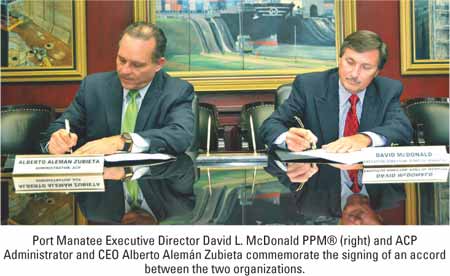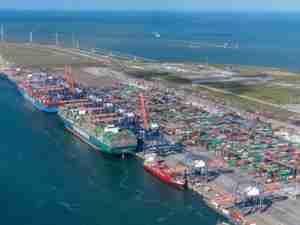The accord, known as a Memorandum of Understanding (MOU), allies the two organizations to achieve increased trade by soliciting shippers worldwide through collaborative marketing and information sharing.
Port Manatee becomes the 10th US member of an exclusive Panama Canal MOU fraternity, including the Port Authority of New York and New Jersey, Georgia Ports Authority, South Carolina State Ports Authority, Virginia Port Authority, Massport, Port of Miami, Port of Tampa, Port of Houston and the Port of New Orleans. Port Manatee, the closest US deepwater seaport to the Panama Canal, is the only nonestablished container port in the group.
“The MOU with the Panama Canal Authority formalizes a relationship we have enjoyed for nearly 40 years and demonstrates the canal’s confidence in Port Manatee’s future as a container port. In time, that confidence will result in thousands of regional jobs,” McDonald predicted after the signing.

Two years ago the Panama Canal Authority (ACP) broke ground on the $5.25 billion Panama Canal expansion. The project essentially doubles the canal’s capacity with the creation of two new sets of locks, enhanced navigational features and the addition of new access channels – all to accommodate larger post-Panamax-sized ships.
Construction is expected to be complete in five years.
“This collaboration is beneficial as we seek innovative ways to provide our customers with the most safe, reliable and efficient service,” added Alemán. “Looking ahead to 2014 and the completion of the waterway, we anticipate growth in trade and the emergence of new economic opportunities – definitely a win-win for our customers, the people of Manatee County (Florida) and the people of Panama.”
Gerhard Kurz, a Florida-based member of the ACP Advisory Board, agrees with Alemán’s perception.
“Port Manatee’s unique geographic location on Florida’s Tampa Bay and proximity to the Panama Canal – combined with its inspired vision for the development of logistics distribution facilities – speak volumes about its future as an emerging container port,” said Kurz, the former president of Mobil Shipping and Transportation Company and former chairman and CEO of Seabulk International.
As part of the partnership, the ACP and Port Manatee will work together in a series of activities to promote both the canal and the port. The agreement demonstrates each organization’s commitment to encouraging increased trade and meeting the needs of today’s maritime and shipping industries.
In preparation for this opportunity, last year the Manatee County Port Authority and Manatee County government collaborated to create the Port Manatee Encouragement Zone (EZ). The EZ features 3,700 acres of privately held land at Port Manatee’s front gate, creating a unique intermodal distribution development opportunity. Local impact fees have been reduced or eliminated in the EZ, based on the type of development and quality and number of jobs created.
Access to the EZ and Interstate 75 will be guaranteed with a proposed east-west connector road, preserving the port’s interstate connectivity. The Florida Department of Transportation is midway through a Project Design and Environment study to determine the preferred alignment for the new road, which will connect with US 41 at the port’s entrance.
Supporting these efforts, the Florida Legislature passed a bill two weeks ago to extend Port Manatee’s exemption from rules governing Developments of Regional Impact (DRI). Developments within the EZ that might otherwise be subject to restrictive DRI rules are spared the years-long process of permitting, speeding new projects forward.
“In anticipation of this opportunity with the










